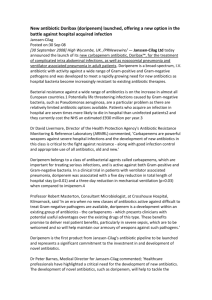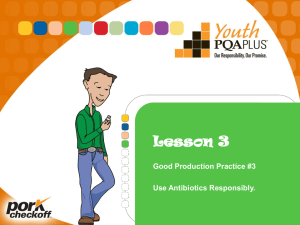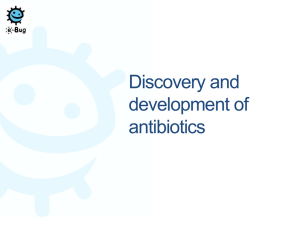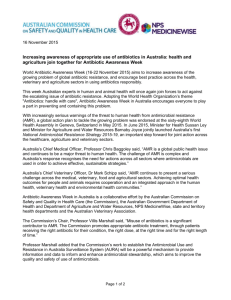JMPC-2011-presentation-John-Turnidge.pps
advertisement
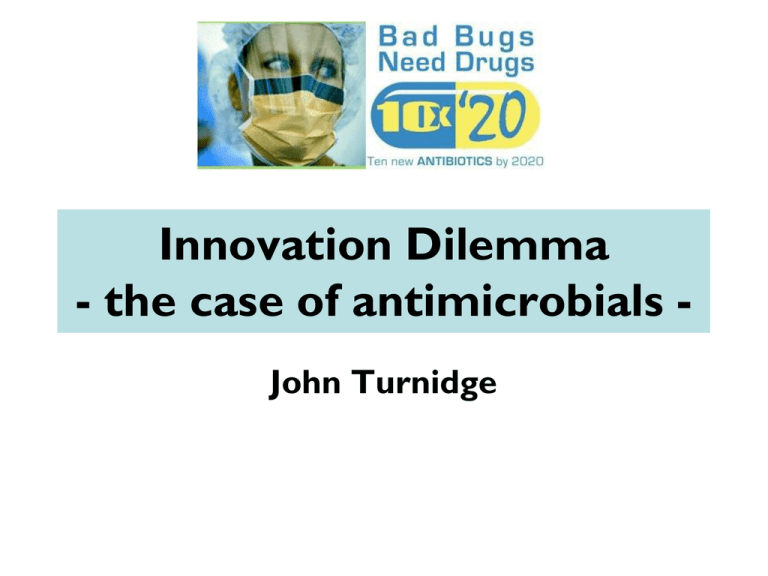
Innovation Dilemma - the case of antimicrobials John Turnidge The trouble with antibiotics • They are designed to be harmless to the host – easy to prescribe “just in case” • They select for resistance which is: – only an uncommon problem for the host – a major problem for the community – doubly contagious (bugs and genes) • We made them widely available to all prescribers right at the beginning (the 1940s) – harder to take away a “right to prescribe” than grant it The trouble with antibiotics • We have set the standard as “cheap” – expectation that they stay that way • We have introduced some high hurdles – cost-effectiveness for the PBS • when the international standard for comparative trials is non-inferiority – prediction of resistance selection potential • what models are available for estimating this? Resistance Issues NOW! • Methicillin-resistant Staphylococcus aureus • Vancomycin-intermediate Staphylococcus aureus • Vancomycin-resistant Enterococcus faecium • Drug-resistant Streptococcus pneumoniae • Extended-spectrum β-lactamase producing and quinolone resistant E. coli and Klebsiella spp. • Carbapenemase-producing Gram-negative bacteria • Multi-resistant Pseudomonas aeruginosa • Carbapenem-resistant Acinetobacter baumannii Four-letter words! • MRSA • VISA • VREF • DRSP • ESBL • CRAB • MBla We are starting to lose our last-line antibiotics From a flood to a trickle And worse to come? Why are we losing antibiotics? • The bugs are becoming resistant faster than we can make new ones Peak Antibiotics? In the last decade in Australia... • New antibacterials that have come and stayed – – – – – – Moxifloxacin Tigecycline Daptomycin Doripenem Quinupristin-dalfopristin Ertapenem • New antibacterials that have come and gone – Gatifloxacin In the last decade in Australia... • Old antibacterials that have gone – – – – – – – – – Piperacillin (alone) Cefotetan Cefpodoxime-axetil Cefpirome Netilmicin Enoxacin Nalidixic acid Ofloxacin oral Spectinomycin In the last decade in Australia... • New antifungals that have come and stayed – – – – Voriconazole Posaconazole Caspofungin Anidulafungin • Old antifungals that have gone – Conventional Amphotericin B – Flucytosine In the last decade in Australia... • New antivirals that have come and stayed – – – – – – – – – – – – valganciclovir oseltamivir entricitabine atazanivir darunavir fosamprenavir lipinavir with ritonavir tipranivir efuvirtide maraviroc ralegravir tenofover In the last decade in Australia... • Antivirals that have gone – zalcitabine – nefinavir So let’s just go and find some new antibiotics... • Find new antibiotic – modify older one (common strategy) – totally new class (better but harder) • Make sure is covers emerging resistances – likely to be broad spectrum • Develop new antibiotic (phase I, II, II) – Cost = USD 500 million to 1 billion • Determine market size and acquisition cost – Typically ~$200 per day for new parenteral antibiotic • Promote – likely to be restricted!! (reserved for last line) What the ID Community is looking for... • Novel classes = novel mechanisms of action – higher development risk (safety issue) • Narrower spectrum drugs – less collateral damage – smaller market • Shorter courses – less collateral damage – less use, higher unit price • New oral agents for the community – only worthwhile if usage likely to be “high” New Industry Model • SMEs – small biotech companies – venture capital funded • In-license molecule for overseas (Japan, Korea) or design new agent • Do all preclinical-phase I work (sometimes phase II) • Sell out to a big multinational to do phase III (they are the only ones with the resources) • Get FDA and EMA clearance ± Australia New Industry Model • “Successful” examples: DORIPENEM – Peninsula Pharmaceuticals (small Californian biotech) – In-licensed doripenem from Shionogi (Japan) – Took it through phase I and II to FDA standards – Sold out to Johnson and Johnson who undertook phase III and filed the NDA – J&J and subsidiaries marketed worldwide – In Australia: fails to take significant market share from meropenem (so far) New Industry Model • “Successful” examples: DAPTOMYCIN – Eli Lilly and company drug discovery program in the 1980s finds novel class (lipopeptides) – Takes lead molecule to Phase II and encounters toxicity problem (myositis) – Enthusiastic ID physician in the US convinces a range of people to obtain the license and resurrect agent – New biotech formed: Cubist Pharmaceuticals – Toxicity minimised by changing dosing to once-daily – Developed and marketed by Cubist in the US – Out-licensed to Novartis for ROW – Novartis markets in Oz but sales are slow and may be looking for another company to market Innovations we don’t need! • Extending the use of reserve agents/classes to areas where benefits are marginal – topical fluoroquinolones! • from sight-threatening eye infections to gooey ears • Extension of indications to undesirable patterns of use: low-dose, long-term – azithromycin in CF • Pseudomonas colonised all CF all COPD – doxycycline for “syphylaxis” trial • “Stealing” antibiotic classes from the veterinary sector – retapamulin (pleuromutilin) Solutions? • Pigovian tax (http://en.wikipedia.org/wiki/Pigovian_tax) • New business models – http://www.reactgroup.org/resources/reactpublications/innovation-ofantibacterials.html New Business Models? • Push mechanisms – Public compound libraries – Patent pooling • Pull mechanisms – Advanced market commitments – Prize funds • Product development partnerships – e.g. Global Alliance for TB Drug Development. Medicines for Malaria initiative Lingering Issues • Regulatory hurdles for safety getting higher • No blockbusters • Reserve status for most new agents for resistant organisms • We must be prepared to pay





